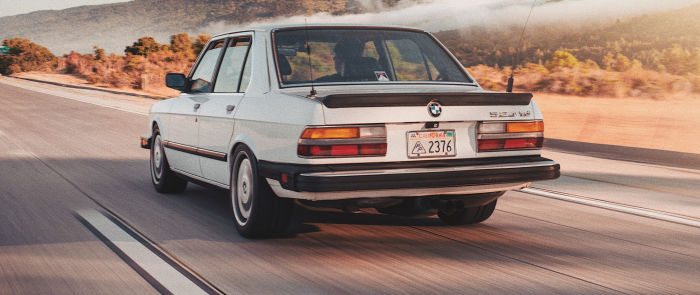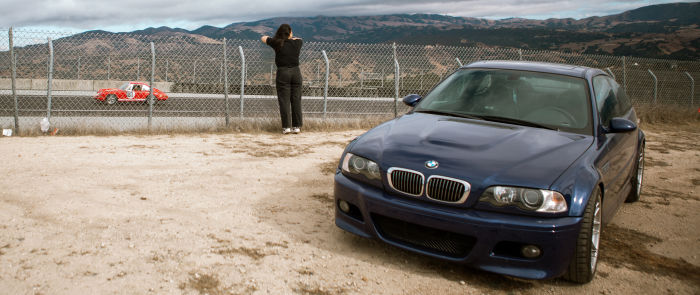Feature
Let's Get Specific: Suspension
Written by Andrew Golseth
“Let’s Get Specific” is a new series we’ll be publishing here on Marqued to help classic car newcomers navigate the nuances of maintaining and enjoying their rides. Whether you’re fixing up a project car yourself or outsourcing your restored vehicle’s maintenance or modifications, knowing where to start and having a general understanding of what to look for can greatly improve your experience.
Part One: Suspension
Today’s lesson is on suspension. Often overlooked and neglected, too many folks are driving around in classics with less-than-optimal suspension, and they often don’t even know it. Classic sports cars, in particular, are beloved for their direct analog handling with ample steering feedback. But if you don’t have a reference point for how your make and model should handle, how are you supposed to effectively gauge whether or not there’s an issue?
Some of the most common symptoms of a tired suspension system are a car sitting lower than stock, excessive play in the steering wheel, uneven tire wear, floaty or bouncy ride, and even bottoming out over bumps. Over time, springs lose their tensile strength, shock absorbers stop dampening spring forces, steering racks get sloppy, and rubber bushings break down and cease doing their job. Your car may have just one of these issues or all of them.
But don’t despair! All of this is totally common and completely solvable. Suspension work is relatively inexpensive and straightforward, and there are ample videos and forums that can help guide you. Addressing these issues will not only make you safer but will also have a transformative effect on your car.
Photographed by Naveed Yousufzai
Let’s start with some basic diagnostics:
Does your car sit too low in the back or front? And if you push down on one of the corners, does it sink very easily? If so, your springs may have lost their spring!
If you’re driving and go over bumps, does the car oscillate up and down a few times? If so, you may have worn-out shock absorbers.
Does your car lean a lot in turns and sway back and forth? You may want to consider new or upgraded anti-sway bars.
Are your tires unevenly worn or does the car drift left or right while driving? If so, your alignment is off, either because of worn parts or because it’s not properly adjusted.
Does your steering wheel move more than a few inches before the wheels start to turn? If so, your steering rack or box may be worn or need adjustment.
Next, let’s get your car up off its wheels so you can give it a good lookover. If you don’t have access to a lift, four trustworthy jack stands will do the trick, with the wheels removed for better access.

How do the bushings look? Check them for cracks and signs of deterioration. Bushings are cheap but absolutely essential bits that help hold your suspension system tight and in alignment. When they start to go out, so does everything else. Luckily, it’s very easy to visually inspect rubber bushings. Check that ball joints are tight and don’t rattle around in their sockets. Examine any rubber boots you find for cracks. Those boots keep out dust and water and hold in much-needed grease. Look over all of the metal suspension items. Just about every vehicle’s suspension will have some superficial surface rust, but if anything looks to be properly rotting, it’s got to go. Pay close attention to the suspension mounting points. If any are rotting, they need to be professionally repaired before the car goes back on the road.
Hold on... what do these parts do?
Shocks (or struts, depending on the application) are used to dampen the ride, meaning absorb and minimize impacts from roadway imperfections, and rebound (bring back up to the set ride height). They also assist in controlling the side-to-side and front-to-back roll of the vehicle during turns and acceleration/deceleration. There are plenty of damper options for different driving dynamics and applications, but ideally, at least for road applications, good shocks will help the vehicle turn flat without sacrificing too much comfort.
Springs hold the car up and absorb road shock. Yours most likely has coil springs, leaf springs, or a combination of the two. Spring choice can lower the vehicle, but there’s more to it than simply a shortened coil. If an aftermarket spring is shorter than a stock unit, it will have less travel (the up-and-down distance of spring compressing/elongating). And to make up for less travel, shorter springs have a higher spring rate, which, in layman’s terms, is the amount of weight needed to compress the spring. If you simply installed a shorter spring with an equivalent spring rate as the longer stock spring, you’d bottom out regularly because the spring would be too “soft” for the reduced suspension travel. Never cut your springs to lower your car.


Sway bars reduce the car’s ability to lean too far to one side or the other. They’re typically u-shaped and under one inch in diameter, connecting left and right sides together. When one side of the car is compressed as you go around a corner, the sway bar twists and prevents the other side from lifting up beyond a certain point. Cars can have sway bars in both the front and the rear. A stiffer sway bar holds the car flatter when cornering and can increase or decrease grip depending on the car and other factors.
Suspension tuning is both figuratively and literally a balancing act. To keep things simple, think of suspension as a priority line: on one end is comfort and the other is performance. You can slide your priority between comfort and performance, but there will always be a sacrifice. The more towards comfort you lean (softer, compliant, and comfortable), the less general performance you gain. The more towards performance you lean (more responsive, communicative, and capable), the less plush your ride quality is. Sports cars are inherently designed with performance in mind, so many enthusiasts are willing to sacrifice some comfort for the improved handling and steering response a lowered ride height offers.
The general benefits of a lowered and firmer ride are sharper steering input response, reduced body roll, less dive under deceleration/acceleration, improved road feedback, and an overall lower center of gravity, which improves traction. The general drawbacks are a harsher ride and other practical issues like the inability to enter steep driveways. Whether you’re rebuilding your suspension back to factory specs or modifying it for performance improvements, the results are well worth the investment.
Everything looks OK under my car. Now what?
Sometimes your suspension will look pretty good, but that doesn’t mean it’s performing as well as it should. This was the case with my recently purchased 1975 Alfa Romeo Spider. Unmodified aside from a twin Weber conversion, the Spider drove as it presented: faded Skipper Blue paint, sun-roasted Oxblood vinyl seats, and a few dings in the dulled, Euro-converted bumpers. The suspension looked old but solid. And despite the lack of obvious suspension faults, the car would dive and bank like an F-16 in a dogfight. I knew it couldn’t be driving as well as Alfa had intended. Thankfully, like many popular classics, old Alfas have strong aftermarket support with thoroughly detailed (and free) how-to installation guides widely available on forums and YouTube. Knowing the Spider was in dire need of new undercarriage hardware, I went to my go-to Alfa Romeo parts emporium: Alfaholics.com. Never one to leave anything unmodified, and having lowered every vehicle I’ve ever purchased, this provided me with the opportunity to not only replace the Spider’s tired springy stuff but also give it a nice modernized upgrade.
The Spider’s bushings and joints were in good shape. So, following recommendations from Alfaholics, I chose to modify the car to perform better at speed. I bought lowering springs and shocks that could dampen them. The Koni Yellow shocks I chose have adjustable damping, which allows rebound adjustment. This type of adjustability allows you to fine-tune the rebound depending on your priorities of performance and comfort. Finally, to reduce body-sway, I added a hefty 29mm front sway bar. This was my second Alfa 105/115 series suspension job, so I knew what tools and techniques were required to complete the task. But if you’ve never taken on a suspension overhaul, please approach the task with caution, especially when removing or installing springs. If you have any doubts at all, take the car to a professional mechanic.
Most coveted classics typically have ample aftermarket suspension support, which means there’s a wide range of options for every budget, from OE-style replacements to full-on race spec, and everything in between. This is why upgrading suspension is so rewarding. Personally, I’m always willing to trade comfort for improved performance, because in my experience, modern adjustable dampers, uprated springs, tougher durometer bushings, and components that offer geometry adjustments, make the comfort trade-offs well worth the driving improvements. My Spider handles so much better than it did on tired shocks and long-travel springs, and it’s made me fall in love with driving all over again.
So what are you waiting for? Go check out your suspension!
Want to keep reading? Check out:
Meet our contributors
When Andrew Golseth isn't scribbling about automobiles he's diligently in his garage restoring his Alfa Romeo GTV.
Stay up-to-date with the latest action and stories on Marqued's Instagram and Facebook pages.
Comments (...)
What to read next

Antares Au's full throttle shift from Wall Street to race track
0 comments

This Malaysian Porsche 911 went from scrapheap to showstopper
0 comments

Enthusiast Roundtable: The BMW E28 is a classic driver for the modern world
0 comments

How Rennsport Reunion 7 transcends Porsche as the ultimate enthusiast gathering
2 comments
Before you get started
Please verify your account. You can do so by clicking on the link in the email we sent you.
Can't find your verification email? Click to resend it.
This website uses cookies. We do this to better understand how visitors use our site and to offer you a more personal experience. We share information about your use of our site with social media and analytics partners in accordance with our Privacy Policy. Additional information for California residents









